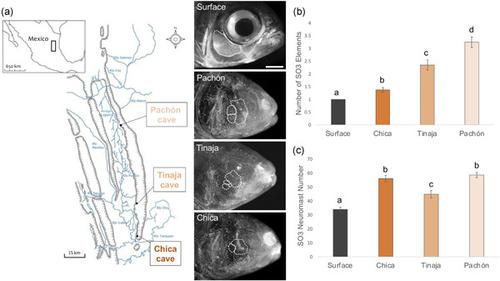当前位置:
X-MOL 学术
›
J. Exp. Zool. B Mol. Dev. Evol.
›
论文详情
Our official English website, www.x-mol.net, welcomes your
feedback! (Note: you will need to create a separate account there.)
Parallel evolution of regressive and constructive craniofacial traits across distinct populations of Astyanax mexicanus cavefish.
Journal of Experimental Zoology-B: Molecular and Developmental Evolution ( IF 1.8 ) Pub Date : 2020-02-06 , DOI: 10.1002/jez.b.22932 Amanda K Powers 1 , Daniel J Berning 2 , Joshua B Gross 2
Journal of Experimental Zoology-B: Molecular and Developmental Evolution ( IF 1.8 ) Pub Date : 2020-02-06 , DOI: 10.1002/jez.b.22932 Amanda K Powers 1 , Daniel J Berning 2 , Joshua B Gross 2
Affiliation

|
Life in complete darkness has driven the evolution of a suite of troglobitic features in the blind Mexican cavefish Astyanax mexicanus, such as eye and pigmentation loss. While regressive evolution is a hallmark of obligate cave‐dwelling organisms, constructive (or augmented) traits commonly arise as well. The cavefish cranium has undergone extensive changes compared with closely‐related surface fish. These alterations are rooted in both cranial bones and surrounding sensory tissues such as enhancements in the gustatory and lateral line systems. Cavefish also harbor numerous cranial bone asymmetries: fluctuating asymmetry of individual bones and directional asymmetry in a dorsal bend of the skull. This asymmetry is mirrored by the asymmetrical patterning of mechanosensory neuromasts. We explored the relationship between facial bones and neuromasts using in vivo fluorescent colabeling and microcomputed tomography. We found an increase in neuromast density within dermal bone boundaries across three distinct populations of cavefish compared to surface‐dwelling fish. We also show that eye loss disrupts early neuromast patterning, which in turn impacts the development of dermal bones. While cavefish exhibit alterations in cranial bone and neuromast patterning, each population varied in the severity. This variation may reflect observed differences in behavior across populations. For instance, a bend in the dorsal region of the skull may expose neuromasts to water flow on the opposite side of the face, enhancing sensory input and spatial mapping in the dark.
中文翻译:

Astyanax mexicanus 洞穴鱼不同种群的回归和建设性颅面特征的平行进化。
完全黑暗中的生活推动了盲墨西哥洞穴鱼Astyanax mexicanus的一系列巨球特征的进化,如眼睛和色素沉着损失。虽然回归进化是专性洞穴栖息生物的标志,但建设性(或增强)特征通常也会出现。与密切相关的表面鱼类相比,洞穴鱼的颅骨发生了广泛的变化。这些改变植根于颅骨和周围的感觉组织,例如味觉和侧线系统的增强。洞穴鱼也有许多颅骨不对称:个体骨骼的波动不对称和头骨背弯的方向不对称。这种不对称性反映在机械感觉神经瘤的不对称模式中。我们使用体内荧光共标记和微计算机断层扫描探索了面部骨骼和神经瘤之间的关系。我们发现与表面栖息的鱼相比,三个不同的洞穴鱼种群的真皮骨边界内的神经瘤密度增加。我们还表明,失眼会破坏早期的神经瘤形成,进而影响真皮骨的发育。虽然洞穴鱼表现出颅骨和神经瘤图案的改变,但每个种群的严重程度各不相同。这种变化可能反映了观察到的不同种群的行为差异。例如,颅骨背部区域的弯曲可能会使神经瘤暴露于面部另一侧的水流中,从而增强黑暗中的感觉输入和空间映射。虽然洞穴鱼表现出颅骨和神经瘤图案的改变,但每个种群的严重程度各不相同。这种变化可能反映了观察到的不同种群的行为差异。例如,颅骨背部区域的弯曲可能会使神经瘤暴露于面部另一侧的水流中,从而增强黑暗中的感觉输入和空间映射。虽然洞穴鱼表现出颅骨和神经瘤图案的改变,但每个种群的严重程度各不相同。这种变化可能反映了观察到的不同种群的行为差异。例如,颅骨背部区域的弯曲可能会使神经瘤暴露于面部另一侧的水流中,从而增强黑暗中的感觉输入和空间映射。
更新日期:2020-02-06
中文翻译:

Astyanax mexicanus 洞穴鱼不同种群的回归和建设性颅面特征的平行进化。
完全黑暗中的生活推动了盲墨西哥洞穴鱼Astyanax mexicanus的一系列巨球特征的进化,如眼睛和色素沉着损失。虽然回归进化是专性洞穴栖息生物的标志,但建设性(或增强)特征通常也会出现。与密切相关的表面鱼类相比,洞穴鱼的颅骨发生了广泛的变化。这些改变植根于颅骨和周围的感觉组织,例如味觉和侧线系统的增强。洞穴鱼也有许多颅骨不对称:个体骨骼的波动不对称和头骨背弯的方向不对称。这种不对称性反映在机械感觉神经瘤的不对称模式中。我们使用体内荧光共标记和微计算机断层扫描探索了面部骨骼和神经瘤之间的关系。我们发现与表面栖息的鱼相比,三个不同的洞穴鱼种群的真皮骨边界内的神经瘤密度增加。我们还表明,失眼会破坏早期的神经瘤形成,进而影响真皮骨的发育。虽然洞穴鱼表现出颅骨和神经瘤图案的改变,但每个种群的严重程度各不相同。这种变化可能反映了观察到的不同种群的行为差异。例如,颅骨背部区域的弯曲可能会使神经瘤暴露于面部另一侧的水流中,从而增强黑暗中的感觉输入和空间映射。虽然洞穴鱼表现出颅骨和神经瘤图案的改变,但每个种群的严重程度各不相同。这种变化可能反映了观察到的不同种群的行为差异。例如,颅骨背部区域的弯曲可能会使神经瘤暴露于面部另一侧的水流中,从而增强黑暗中的感觉输入和空间映射。虽然洞穴鱼表现出颅骨和神经瘤图案的改变,但每个种群的严重程度各不相同。这种变化可能反映了观察到的不同种群的行为差异。例如,颅骨背部区域的弯曲可能会使神经瘤暴露于面部另一侧的水流中,从而增强黑暗中的感觉输入和空间映射。











































 京公网安备 11010802027423号
京公网安备 11010802027423号